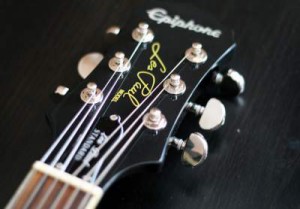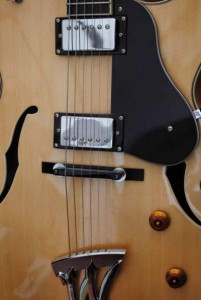It is important to know the different parts of the electric guitar because at some stage you may need to adequately give an account of your instrument to other guitar players. The electric guitar consists of three main parts:
- head
- fingerboard
- body
Head
The upper part of the electric guitar is known as the headstock. It consists of tuning keys which are responsible for tuning the strings of the guitar. On some electric guitars, such as the Fender Stratocaster, the tuning keys are all on the same upper side of the head. Other electric guitars such as the Maton or Gibson brand of guitar, have 3 tuning keys on the upper side and 3 tuning keys on the lower side of the head. The little parts connected to the tuning keys are called the tuning pegs or string pegs. They have little eyelets where you attach the strings to the guitar.
Electric guitars can have a truss rod cover located in the head. If it is located in the headstock, you have to take the cover off to access the truss rod. The truss rod is responsible for putting a bow in the neck of the guitar to enable the right amount of neck relief.The idea is to lower the strings towards the neck as close as possible without fret buzz. ‘Fret buzz’ is that irritating sound of a guitar string humming against a fret wire when the guitar is being played.
If it is located in the headstock, you have to take the cover off to access the truss rod. The truss rod is responsible for putting a bow in the neck of the guitar to enable the right amount of neck relief.The idea is to lower the strings towards the neck as close as possible without fret buzz. ‘Fret buzz’ is that irritating sound of a guitar string humming against a fret wire when the guitar is being played.
Fingerboard
Next comes the nut which is the ledge at the upper end of the fingerboard over which the strings pass. The nut can be made out a few mdifferent materials including bone, ebony and micarta which is a plastic. I believe you manage a better tone from bone. The grooves in the nut hold the strings in place before they go to the tuning peg.
The fretboard is normally glued onto the neck of the guitar and can be made of maple which is a light color or rosewood which is a darker color.
Twenty four strips of fret wire are embedded across the fretboard separating the frets. Strings are pressed down behind the frets helping the fingers to locate the different notes on the strings.
Most guitars have decorative inlays or fret markers at the 3rd, 5th, 7th, 9th and 12th frets. The reasons for the inlays are for aesthetic purposes and to help you visualize where you are on the fingerboard. The inlays can be dots or more decorative shapes and may be made from abalone or mother of pearl.
The Body
The pickguard protects the guitar so that you do not scratch the guitar when you are using your pick at the point of most contact.
guitar when you are using your pick at the point of most contact.
The bridge is located on the lower part of the body of the guitar. This is where the stings attach. They can be different depending on the type of electric guitar. The bridge can be raised or lowered with two screws at either edge of the bridge. The main purpose of the bridge is to support the strings at a uniform height from the fretboard and maintain correct string alignment and spacing by holding the strings in place.
A tremolo bar may be attached to the bottom end of the body near the bridge and this alters the pitch of the strings.
Electric guitars have magnetic coils to amplify the vibrations of the strings through a speaker. They are called pickups and they may have one, two or three of them. There are several types of pickups but two basic varieties, namely single coil and humbuckers. They are identified by their position on the body of the guitar. The ones closest to the neck is naturally called the neck pickup, the one closest to the bridge is called the bridge pickup and then the middle pickup.
Pickup selector switches allows you to select which pickup to use. All electric guitars have pots which adjusts the tone or volume of each pickup.
Electric guitars may have a single or double cutaway section. The cutaway is a indentation in the part of the body adjacent to the neck of the guitar. It is designed to allow guitar players easier access to the higher frets and therefore the higher notes.
